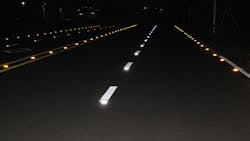Safety in Retroreflectivity
By Paul J Carlson, Contributing Author
Over 30 years ago, Congress required the Federal Highway Administration (FHWA) to produce a standard that agencies can use to determine when pavement markings need to be maintained.
On Aug. 5, 2022, the FHWA published a final rule on minimum pavement marking retroreflectivity, with an effective date just 30 days later. The final rule has been incorporated into the Manual on Uniform Traffic Control Devices (MUTCD), which is recognized as the national standard for traffic control devices on all streets, highways, bikeways and private roads open to public travel.
The final rule was officially incorporated into the Revision 3 of the 2009 MUTCD and is expected to be the same in the 11th Edition. Improving nighttime safety and driver visibility is one of the primary reasons for establishing a threshold to maintain retroreflective pavement markings.
According to the FHWA, the U.S. nighttime fatal crash rate is approximately three times than the daytime crash fatal crash rate. But the threshold levels that FHWA has established in the final rule are not directly based on improved safety—rather, they are mostly based on the nighttime visibility needs of older drivers.
This theory is tied to safety, but evidence-based research has shown that to improve nighttime safety for all motorists, different thresholds of retroreflectivity should be considered to reduce nighttime crash rates.
While exceptions and other factors apply, the required MUTCD minimum retroreflectivity level has been set to 50 mcd/m2/lx (mcd/m2/lx is a measure of how much light will be reflected at a given illuminance) for longitudinal markings on roadways with speed limits of 35 mph or greater.
This applies to white and yellow longitudinal markings. For roadways with speeds limits of 70 mph and greater, a higher level of 100 mcd/m2/lx is suggested but not required.
These conditions are based on an older driver being able to see nighttime markings with about 2.2 seconds of preview time. They do not include adverse conditions such as weather, oncoming vehicles, other glare sources, or complex backgrounds.
While the MUTCD minimum pavement marking retroreflectivity levels provide some possible relief when continuous lighting is present, they do not provide relief when retroreflective pavement markers are used.
To better understand the safety impact of pavement marking retroreflectivity, researchers studied the retroreflectivity of yellow center lines on Michigan highways using nighttime crashes and single-vehicle nighttime crashes.
When the yellow retroreflectivity levels were below 150 mcd/m2/lx, nighttime crashes were found to increase at a statistically significant rate. The findings also showed that the expected crash frequency decreases as the yellow center line retroreflectivity approaches the 150 mcd/m2/lx level.
A follow-up study using the same data but by using more advanced analysis techniques, was able to establish a safety-derived minimum threshold value for the maintenance of yellow center line markings on rural two-lane highways of 175 mcd/m2/lx.
There are many factors to consider developing a cost-effective pavement marking program. For instance, setting initial and maintenance levels for retroreflectivity is only part of the equation. Selecting the right binder material, such as paint or thermoplastic, as well as the correct retroreflective optic bead.
Not all binder and optics wear at the same rate; therefore, measuring your markings can also be an important consideration. Measurement equipment falls in two general categories: handheld, where a lane closure is often required to ensure worker safety, and mobile, which keeps traffic and the project moving.
Pavement markings have been used on our roadways for over 100 years, and they will become even more important as vehicle cameras and other sensors provide automated vehicle features. Efforts are underway to understand how agencies can better prepare and maintain their roadways for these new technologies, which promise to improve mobility, safety, relieve congestion, and save lives. RB
